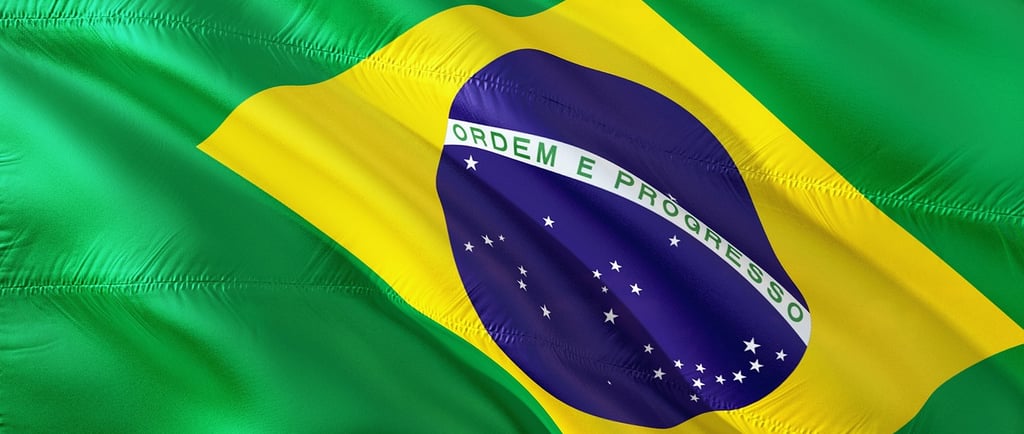🏞️ The Flag of Brazil: Colors of the Jungle and Sky 🇧🇷
A flag story invites children into the fascinating world of symbols, colors, and shapes that represent countries around the globe. 🌍🇦🇺🇫🇷 In "Flags of the World," each flag reveals a story—of ancient legends, natural landscapes, and the hopes and dreams of a nation’s people. 🌞🏔️ This exploration encourages children to see flags not only as symbols but as connections to the world’s shared heritage, inspiring questions like, “Why these colors?” and “What does this symbol mean?”
GEOGRAPHY STORIES
11/8/20243 min read


Brazil’s flag is like a treasure map of colors and shapes, each one packed with surprises about the country’s nature, history, and big dreams! From lush jungles to shining stars, every detail tells a fun story about what makes Brazil so unique.
🟢The flag has a green background with a yellow diamond in the center. The green stands for Brazil’s amazing rainforests and landscapes, including the famous Amazon jungle. The yellow diamond represents the natural riches of Brazil, like gold, found in its soil.
🔵Inside the yellow diamond is a blue circle that stands for Brazil’s sky. In the blue circle, there are 27 stars arranged to look like the night sky over Rio de Janeiro on the day Brazil became a republic! Each star represents a state in Brazil, showing that the whole country is united.
📜 Across the blue circle is a banner with the words "Ordem e Progresso", which means "Order and Progress" in Portuguese. These words show Brazil’s hopes for peace and growth, encouraging everyone to work together toward a bright future.
🦜Local legend says that, Brazil’s vast Amazon jungle is protected by a magical parrot that watches over the land. The parrot is said to bring good luck to those who respect the forest. The green and yellow on Brazil’s flag are inspired by the Amazon’s lush greenery and the golden treasures of the land, like the parrot’s colorful feathers. This legend reminds Brazilians of the importance of their natural environment and its role in the nation’s wealth and beauty.
📅 Brazil’s flag was adopted in 1889 after the country became independent. The flag’s design reflects Brazil’s beautiful nature, its proud history, and its hopes for the future.
🎉 Every year on November 19, Brazil celebrates National Flag Day! It’s a special day when people honor the flag, learn about its history, and celebrate their country’s spirit. On this day, you’ll see the flag flying high everywhere as Brazilians come together to show their pride.
Whenever you see Brazil’s flag 🇧🇷, remember it’s a colorful symbol of Brazil’s amazing landscapes, rich natural treasures, and the hope for unity and progress among its people.And there are other flag stories which you can find in the Geography shelf.
Follow-Up Projects 🌍🏳️🌈
🎶 National Anthem: Brazil’s anthem, “Hino Nacional Brasileiro,” is an energetic and joyful song that celebrates the country’s beauty, freedom, and spirit. Listen to the anthem and feel the rhythm that makes it so lively! How does it sound compared to other anthems? Discover the instruments, like the guitar and drums, that make Brazilian music so unique, and explore what the anthem’s words say about Brazil’s love for its land and people.
🥘🌳🦜 National Symbols: Brazil’s national symbols are as vibrant as the country itself! Discover the Amazon Rainforest, often called the “lungs of the Earth,” which is home to countless plants and animals. Meet the golden lion tamarin, a small, endangered monkey, and explore why the Ipê-Amarelo tree, with its golden blooms, is Brazil’s national tree. And, of course, don’t miss feijoada—a delicious black bean stew that’s a national favorite! What do these symbols tell us about Brazil’s love for nature, culture, and unique wildlife?
✍️ Write Flag Stories: Imagine creating your own story about a country’s flag! Choose any flag that fascinates you and think about its colors and symbols. What do they mean to you?
🗺️ Note for Flag Presentations:
I will present one story for a flag, while the rest of the flag stories will be printed as materials for the Geography shelf. When sharing a flag story, I’ll use a map to show where the country is located, helping children connect the flag with the country's geography and understand its place in the world. This approach not only gives context to each story but also encourages children to explore maps, learn about continents and countries, and discover how geography shapes culture.
With Montessori joy,
Vanina 😊

